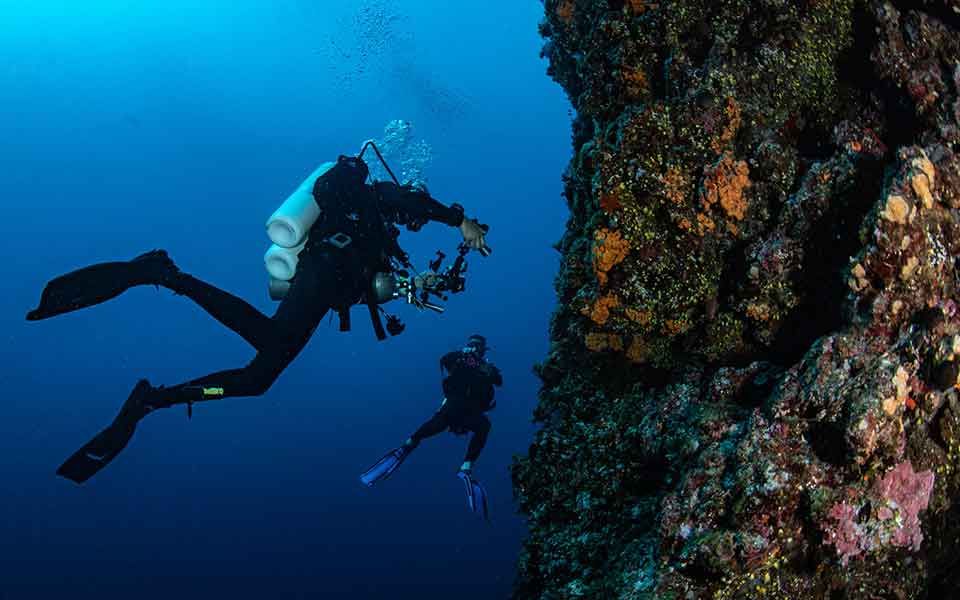Deep in the sea, where light is scarce, there is a different colorful world. The coral gardens, slowly growing on the reefs, provide the space to create a precious and beautiful canvas of marine life forms. These formations are largely unknown. Only recently has a research team studied such an ecosystem in the Alonnisos National Marine Park, providing primary scientific information, and revealing the acute dangers they face from ‘careless’ fishing and climate change.
The study of the coral gardens was carried out in 2021 with funds from the Thalassa Foundation. The team was composed of the diver Dimitris Poursanidis, PhD in marine ecology and founder of the research company terraSolutions marine environment research, Giovanni Cimienti, PhD in marine biology, and Michaela Majorca, marine biologist.
The research was carried out at a depth of 30-50 meters, a zone called the mid-light zone – because the light reaching those depths corresponds to about 3% of that reaching the surface – at five different points in the Skopelos-Alonissos Strait (at Moules and the Barqueta reef). It is in this zone that the coralligenous formations develop – they are called coralligenous, not coral formations because they are not corals like those found in the tropics, but “calcified,” i.e. petrified rose algae, which are transformed into colonies. “These formations are biogenic structures,” Poursanidis explains. “Their base is mainly red, orange and purple algae, which have a special characteristic. They coat their cell walls with calcite, one of the crystalline forms of calcium carbonate which is found dissolved in seawater. Thus, at a very slow rate of only 2 mm per year, the stone flowers grow.
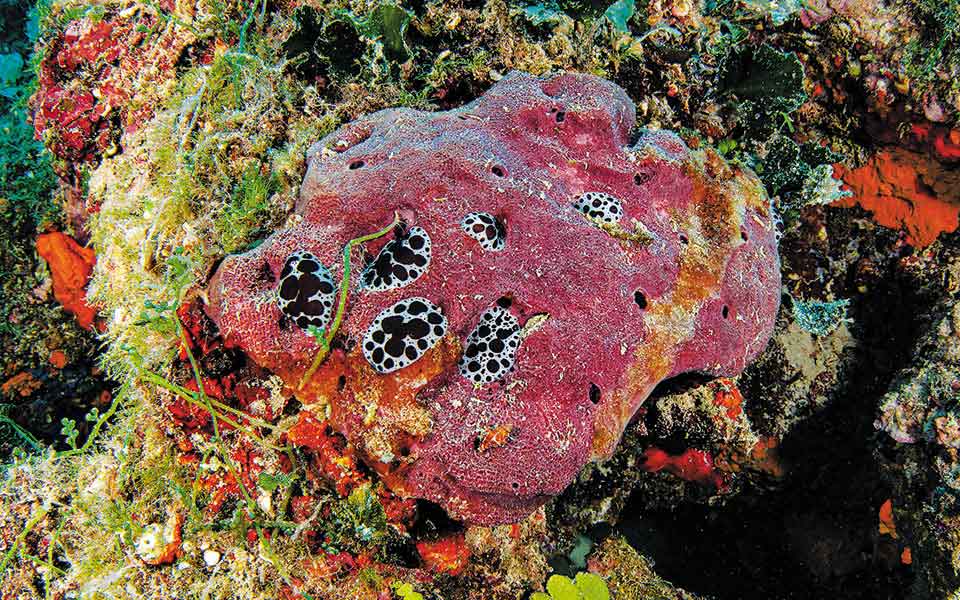
© Dimitris Poursanidis
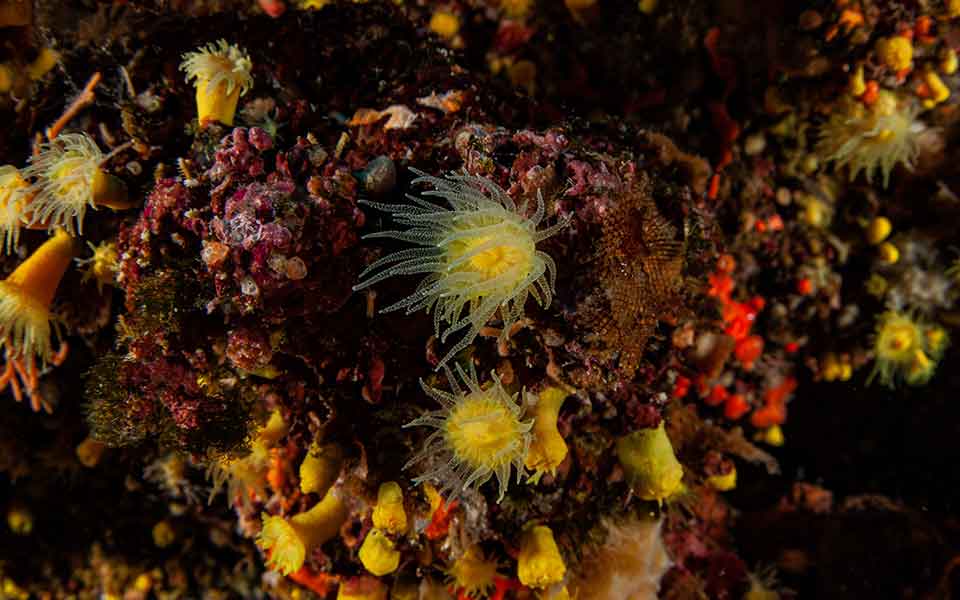
© Dimitris Poursanidis
These beautiful formations become home to dozens of species of marine organisms. “As they grow, they form holes, bumps and other formations that allow other life forms such as marine worms, gastropods and bivalves to be created safely. These will hide in the holes and emerge when their predators are not present. This is a symbiotic world: fish move alongside them, feeding on available life forms, sponges grow in various forms, gorgonians grow: colonies of ‘octocoral anthozoans’ (so called as each polyp has eight tentacles that capture food), forming soft fan-shaped ‘trees’ that resemble corals. Because of the density, shape and structure of the gorgonians, they are considered ecological engineers, as they change local hydrodynamic and oceanographic conditions, while they create a form of ecological subsystem, a phase in deep reefs,” Poursanidis explains. “Characteristically, these fans attract a multitude of organisms so as to hide, feed or lay their eggs, such as various species of sharks that lay their egg sacs there. The gorgonians have different colours – yellow, purple, white, pink – and look like gardens in spring.”
This unique world is found at specific depths for specific reasons. “It is found at great depths because it can withstand a minimal amount of solar radiation,” says Dr Poursanidis. “It also needs areas with sea currents because it feeds on microorganisms carried in the water. In the North Aegean these ecosystems are found after 30 meters, while in the South Aegean after 90 meters, because the waters there are clearer and the light penetrates deeper.”
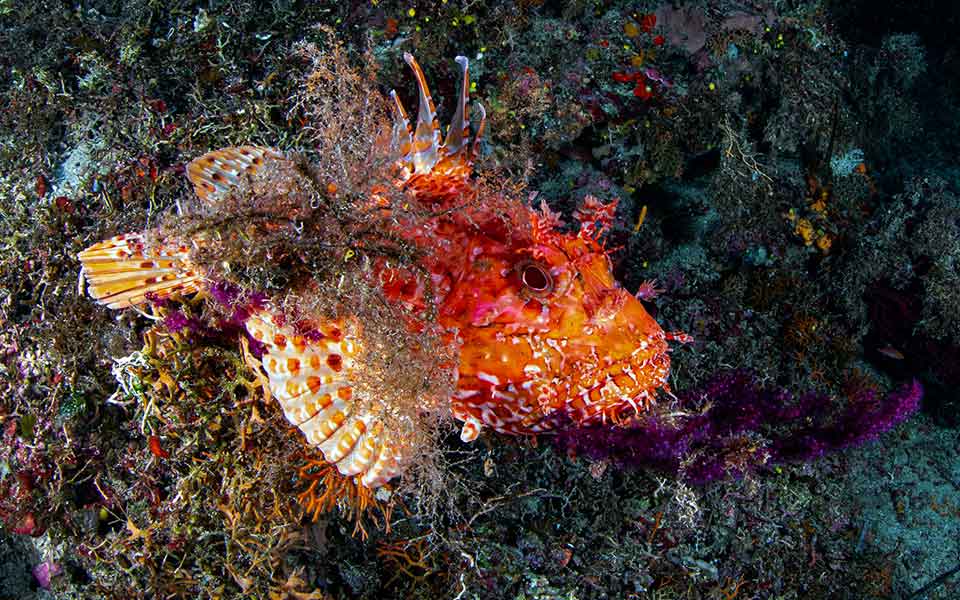
© Dimitris Poursanidis
Despite their depth, the ecosystems face various threats. “Reefs are places of high productivity and therefore attract fish. Fishermen often fish around them, but sea currents drift the nets up onto the formations and when they are retrieved, the formations drift away. Sometimes fishermen risk casting nets or longlines too close to the reefs to catch ‘good’ fish and tear up coralligenous formations. Very often we find ghost nets or longlines blocked on these formations. Another risk, currently unmanageable, is climate change. The rising in sea temperatures is killing off the gorgonians or is allowing their natural predators, such as starfish, scolopentra and fireworms, to descend to greater depths and eat them.”
The research team mapped the coralligenous zones in these areas using special equipment (digital video and image systems, laser pointers to measure distances). In this way, the researchers can then measure, the dimensions of each colony in the video and images and understand the situation and the pressures they are under both now and in past times. The results will be published in a scientific journal and then delivered to the Natural Environment and Climate Change Agency (NCCA), along with suggestions for the management of the specific area, to be used in the special environmental study that is being prepared.
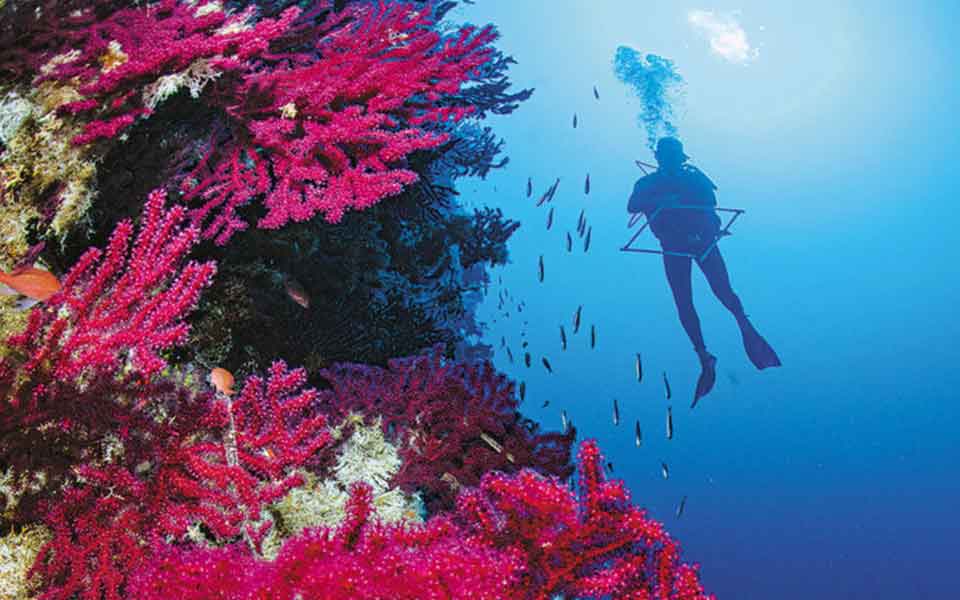
© Dimitris Poursanidis
It is worth noting that this particular survey is one of the few that have been carried out in the Aegean. Similar surveys have been carried out in the past in specific areas in Lesvos, Pagasitikos, Chalkidiki and the Corinthian Gulf.
“Mapping of Natura marine sites is essential for the preparation and implementation of management measures. In addition, research should also be carried out outside Natura marine sites, as there are new corresponding sites to be included in the network of marine protected areas. Regarding the Alonissos National Marine Park, once we have completed the data processing for the areas we have surveyed, we will propose a series of management measures to reduce the impact of anthropogenic activities,” concludes Dr Poursanidis.
This article was first published in Greek at kathimerini.gr.

